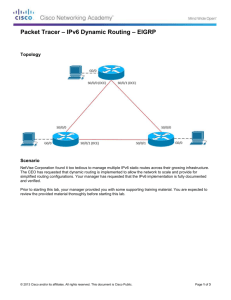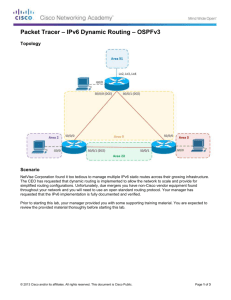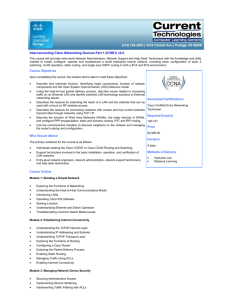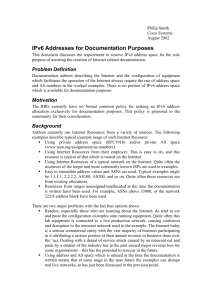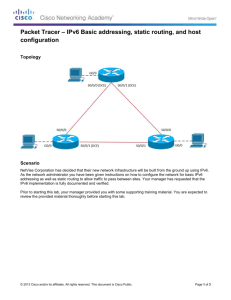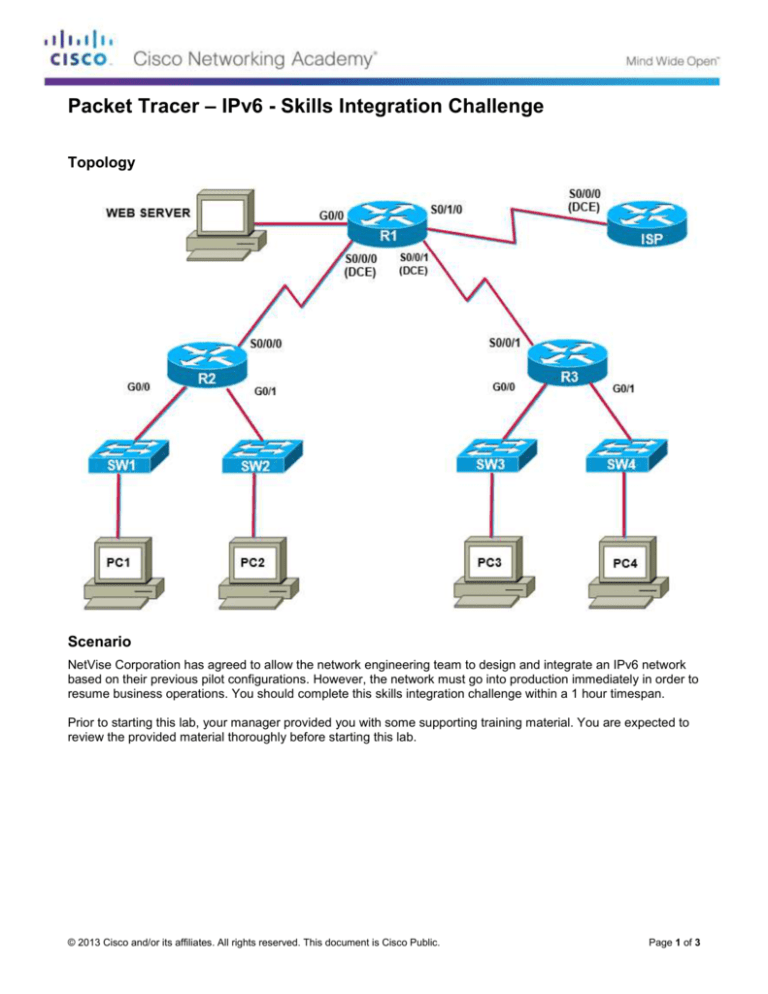
Packet Tracer – IPv6 - Skills Integration Challenge
Topology
Scenario
NetVise Corporation has agreed to allow the network engineering team to design and integrate an IPv6 network
based on their previous pilot configurations. However, the network must go into production immediately in order to
resume business operations. You should complete this skills integration challenge within a 1 hour timespan.
Prior to starting this lab, your manager provided you with some supporting training material. You are expected to
review the provided material thoroughly before starting this lab.
© 2013 Cisco and/or its affiliates. All rights reserved. This document is Cisco Public.
Page 1 of 3
Packet Tracer – IPv6 – Skills Integration Challenge
Addressing Table
Device
Interface
ISP
Type
S0/0/0
Global Unicast
S0/0/0
Global Unicast
S0/0/1
Global Unicast
S0/1/0
Global Unicast
G0/0
Global Unicast
S0/0/0
Global Unicast
G0/0
Global Unicast
G0/1
Global Unicast
S0/0/0
Global Unicast
G0/0
Global Unicast
G0/1
Global Unicast
PC1
NIC
Static
PC2
NIC
Static
PC3
NIC
EUI-64
PC4
NIC
DHCPv6
Web Server
NIC
Static
IP Address
Prefix
Default Gateway
R1
R2
R3
Objectives
Develop hierarchical IPv6 addressing scheme
Assign interfaces and hosts IPv6 addresses
o
Static
o
EUI-64
o
DHCPv6
Configure IPv6 dynamic routing using EIGRPv6
Configure static and default routing to support the network requirements
Utilize access control lists to restrict web server access
© 2013 Cisco and/or its affiliates. All rights reserved. This document is Cisco Public.
Page 2 of 3
Packet Tracer – IPv6 – Skills Integration Challenge
Task 1: Develop hierarchical IPv6 addressing scheme and assign interfaces and hosts IPv6 address
appropriately.
Step 1: Your ISP has assigned the global prefix of 2001:acad::/64, given this information you must develop an
IPv6 addressing scheme to meet the network requirements. Document all IPv6 address information in the
address table provided.
Step 2: Assign network infrastructure interfaces with IPv6 addresses according to the address table and enable
IPv6 unicast routing.
Step 3: Assign hosts with IPv6 addresses according to the address table.
Web server, PC1, and PC2 are all assigned statically, no additional configuration is required besides
manually entering the IPv6 address and default gateway in the GUI.
PC3 should be enabled for stateless autoconfiguration, by selecting “auto-config” for the IPv6 address
and default gateway.
R3 should be configured as a DHCPv6 server to issue IPv6 address information to PC4.
o Address Prefix: 2001:acad:0:32::/64
o Domain Name: netspace.com
o DNS Server: 2001:4860:4860::8888
Task 2: Configure IPv6 dynamic routing using EIGRPv6
Step 1: Enable EIGRPv6 and assign router-ids, use an autonomous system number of your choosing.
R1 – 1.1.1.1/32 Lo0
R2 – 2.2.2.2/32 Lo0
R3 – 3.3.3.3/32 Lo0
Step 2: Enable the appropriate interfaces for EIGRPv6 to allow for full reachability.
Step 3: Summarize networks coming from R2 LAN interfaces.
Task 3: Configure static and default routing to support the network requirements
Step 1: Redistribute default route into the EIGRP process for R2 and R3 to reach the internet (ISP).
NOTE: A bug occurs when you attempt create a loopback address for the static default route, it will not
show up in the routing table, in this case a physical interface is used, but is against best practice.
Step 2: Configure a default static route on the ISP Router to allow full reachability.
Task 4: Utilize access control lists to restrict web server access
Step 1: Create an ACL that blocks HTTP and FTP traffic sourcing from PC1 and PC2 and permits all other traffic
from any sources.
© 2013 Cisco and/or its affiliates. All rights reserved. This document is Cisco Public.
Page 3 of 3

